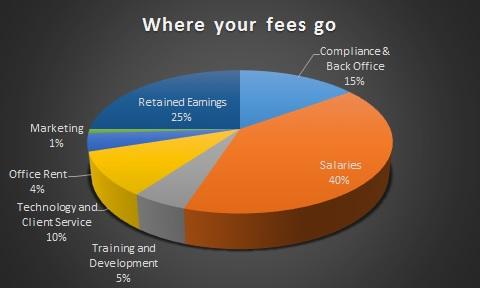Recently, the Globe and Mail created a tool for investors to compare if they are paying more or less for advice than other investors who complete the questionnaire do.
Fee transparency is important, and it got us thinking that how advisors spend those fees is also important and can provide clients with insights as to the business values of their advisor. So we analyzed our allocation of revenue and shared the results in our most recent client newsletter.
Perhaps the broader public is also interested, hence this blog post.
A recent analysis of our practice showed the following breakdown:

*information compiled internally
Compliance and Back Office 15% – This is the cost of all services provided by Queensbury Strategies, our investment dealer. We value Queensbury as a platform to provide conflict free advice and service without the pressure of sales quotas, within a collegial and supportive culture. When I worked at CIBC Wood Gundy, this percentage was over 50%. Keep in mind that the bank provided an employee, a workstation for me and my employee, and the brand value of Wood Gundy. In spite of this, for many reasons for the benefit of clients and my practice, I left the firm 15 years ago to become an independent advisor.
Salaries 40% – This includes staff salaries, health and dental benefits, CPP and other payroll related costs. As an independent, I’m on the hook for these expenses. However, rather than having only one dedicated support staff, I’ve chosen to have three. Two associate financial planners and one administrative assistant. The additional staff enable us to deliver a much more comprehensive and responsive service to clients. Furthermore, this strong base of expertise ensures seamless support to clients when I am on vacation or at home with the flu. These great young talents are also the future of the practice, and will hopefully be around long after I have retired.
Training and development 5% – This includes courses and exams related to continuing education and skills development for the entire team. Continuing education is a priority at Caring for Clients, and as you can see we invest a great deal more on training and development than we do on marketing. Our view is that if we strive for continued excellence, growth in clientele will naturally follow.
Marketing 1% – This includes all activities related to marketing and promotion. New clients come from three sources: existing client referrals, referrals from other professionals, and unsolicited inquiries through our website. We have invested a lot of time on delivering value to existing clients, building professional relationships beyond our clientele, and in building a reputation as an industry leader which shows up in our media mentions and growing web presence. Our efforts in this regard are resulting in business growth that is not reliant on advertising and traditional sales and marketing.
Technology and Client Service 10% – We are constantly investing in our planning technology, and are currently investing in the development of a new client portal that will make the client onboarding experience an even more pleasant one. The online portal will be expanded over time as we identify opportunities to use technology to enhance the client experience. In addition, we look for ways to express how much we value our clients and these expenses fall into this category too.
Office Rent 4% – The cost of one office and two workstations in downtown Toronto. So far, my team member, Alexandra doesn’t mind sharing an office with me. I try to be on my best behavior! J We are in a great building in a convenient location that our clients seem to really like.
Retained Earnings 25% – Otherwise known as profit. This is the part that is available for annual bonuses for staff, and for investing in the future of the business such as hiring additional staff when needed. It is also important to run a profitable business to ensure sustainability during cyclical downturns when revenue falls. Ours is a cyclical business, and operating conservatively from a financial standpoint means that we can stay focused on client service even when revenues decline, which happens during a bear market. A secure business is one that will be around over the long term. Given the fact that our clients will need us over the long term, we view this as an important strength.
By the way, I used the Globe and Mail fee comparison tool to see where our fees stand in the marketplace. I was pleased to see that as full-service planners and wealth managers, in all categories, our clients pay less than average, while (in our view) getting more advice and service than average.
This information is of a general nature and should not be considered professional advice. Its accuracy or completeness is not guaranteed and Queensbury Strategies Inc. assumes no responsibility or liability.

